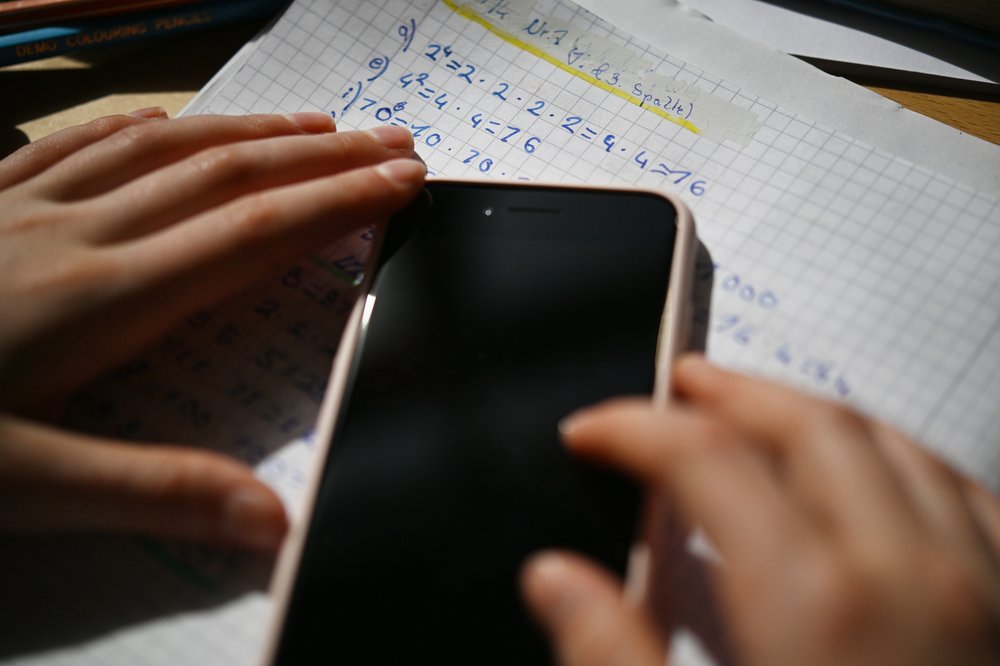Here are the exceptions to the phone ban coming to NY schools
May 17, 2025, 7 a.m.
The ban exempts students who need smartphones for health care purposes, translation apps or a disability, as well as those who have responsibilities as caregivers.

The smartphone ban is coming to New York’s schools next fall, but there are exceptions that raise new questions for educators implementing the transformative policy.
The new “bell-to-bell” ban exempts students who need smartphones for health care purposes, translation apps or a disability, as well as those who have responsibilities as caregivers. Students who don’t fall into those categories will only be allowed to have flip phones — which the rules call “non-internet enabled phones” — during class hours.
As a result, some educators and parents wonder if the policy will create a new dynamic where iPhones bring unwanted attention to students with disabilities or those who are migrants.
Paullette Healy, a parent and disability advocate, said she worries about the stigma potentially facing students with disabilities who will rely on smartphones in class.
“Many of these kids, the last thing they want is to draw attention to is themselves and their disabilities,” said Healy, who opposed the ban. She noted that students with dyslexia sometimes use text-to-speech programs. Students with attention deficit disorder sometimes benefit from organizational apps.
- heading
- Exemptions to the school smartphone ban
- image
- image
- None
- caption
- body
- A teacher, principal or school official authorizes the smartphone for specific educational purposes.
- If a device is necessary for a student’s health care, such as glucose monitoring for diabetic students.
- For translation services.
- If a student with special needs requires a device as part of their Individualized Education Plan or 504 plan, such as text-to-speech apps for students with dyslexia and organizational apps for students with attention deficit disorder.
- If a student is a caregiver for a family member and has received permission from a school psychologist, social worker or counselor.
Teacher Kristi Jones said she had similar concerns about the many migrant students at her Manhattan high school who use smartphones for translation.
Jones said it could be harder for those children to resist checking social media on their phones, potentially setting them up for problems with their teachers enforcing the new rules.
“I can't name a single student using their phone for translation who is not also on TikTok,” she said.
The New York Civil Liberties Union has warned the smartphone ban could lead to more policing of students and disparities in discipline. The legislation bars administrators from suspending students solely for using smartphones and calls on districts to report and mitigate “demographic disparities in enforcement.”
Polls show most teachers and parents favor the ban. Gov. Kathy Hochul said it comes in response to the growing body of research that finds access to smartphones in schools has contributed to an epidemic of distraction and worsened the toxic effects of social media, including fights and conflicts.
Mayor Eric Adams has also supported the ban.
“As Mayor Adams has repeatedly said, access to cell phones during the school day distracts our children from learning, divides their attention and harms their mental health," City Hall spokesperson Zachary Nosanchuk said in a statement. "We are reviewing the final language and funding details [of the ban]."
Multiple teachers noted those details will be crucial.
Mike Stivers, a high school teacher in Brooklyn, said the ban is necessary. “It’s time,” he said. “This system isn’t working.” But Stivers had questions about the logistics of storing the phones, as well as potential liability if a student's phone breaks or is lost.
Under the ban, schools will have discretion over whether to collect phones from students at the start of the school day and lock them away, seal them up in individual pouches that the students keep, or allow kids to keep them in their lockers.
Students at schools that have already implemented bans said many of their classmates find workarounds.
Mia Wayne, a middle schooler at the Clinton School in Manhattan, said some students break into the magnetic pouches where their phones are supposed to be stored during the day.
“I feel like people use their phones more now because it’s more of a challenge,” she said.
The pouches cost students $25 to replace if they report them as broken, which many don’t, she said.
But Wayne's friend Elise Constantino said she is in favor of the pouches at her school and a smartphone ban generally.
“I know from experience if I have my phone I tend to go on it a lot, so I think having your phone locked up can mean better social experiences,” she said.
‘Bell-to-bell’ smartphone ban in NY schools is on track to become law